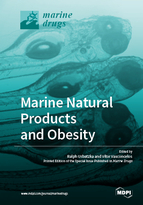Marine Natural Products and Obesity
A special issue of Marine Drugs (ISSN 1660-3397).
Deadline for manuscript submissions: closed (29 March 2019) | Viewed by 68594
Special Issue Editors
Interests: bioactivity screening; natural products; elucidation of molecular mechanism; obesity and related diseases; cyanobacteria bioactive compounds
Special Issues, Collections and Topics in MDPI journals
2. CIIMAR, Interdisciplinary Centre of Marine and Environmental Research of the University of Porto, 4450-208 Porto, Portugal
Interests: cyanobacteria; toxins; cyanotoxins; marine biotechnology; secondary metabolites; cyanobacterial blooms; ecotoxicology; environmental contamination
Special Issues, Collections and Topics in MDPI journals
Special Issue Information
Dear Colleagues,
Obesity and related co-morbidities are increasing worldwide and pose a serious health problem. Changes in lifestyle and diet would be the best remedies to fight obesity; however, many people will still rely on medical aid. Marine organisms have been prolific in the production of bioactive compounds for many diseases, e.g., cancer, and promise to be an excellent source for natural-derived molecules and novel nutraceuticals. Bioactive compounds with beneficial activities towards obesity have been described from diverse marine organism including marine algae, bacteria, sponges, fungi, crustaceans or fish.
This Special Issue will highlight the progress in the following topics: Bioactive compounds for the treatment of obesity and obesity-related co-morbidities (diabetes, fatty liver, hyperlipidemia) from marine organisms; the isolation of novel compounds, the bioactivity screening of marine organisms and the elucidation of molecular mode of action of marine bioactive compounds.
Dr. Ralph Urbatzka
Prof. Dr. Vitor Vasconcelos
Guest Editors
Manuscript Submission Information
Manuscripts should be submitted online at www.mdpi.com by registering and logging in to this website. Once you are registered, click here to go to the submission form. Manuscripts can be submitted until the deadline. All submissions that pass pre-check are peer-reviewed. Accepted papers will be published continuously in the journal (as soon as accepted) and will be listed together on the special issue website. Research articles, review articles as well as short communications are invited. For planned papers, a title and short abstract (about 100 words) can be sent to the Editorial Office for announcement on this website.
Submitted manuscripts should not have been published previously, nor be under consideration for publication elsewhere (except conference proceedings papers). All manuscripts are thoroughly refereed through a single-blind peer-review process. A guide for authors and other relevant information for submission of manuscripts is available on the Instructions for Authors page. Marine Drugs is an international peer-reviewed open access monthly journal published by MDPI.
Please visit the Instructions for Authors page before submitting a manuscript. The Article Processing Charge (APC) for publication in this open access journal is 2900 CHF (Swiss Francs). Submitted papers should be well formatted and use good English. Authors may use MDPI's English editing service prior to publication or during author revisions.
Keywords
- marine bioactive compounds
- obesity and related co-morbidities (diabetes, fatty liver, hyperlipidemia)
- bioactivity screening
- structural elucidation
- molecular mode of action








